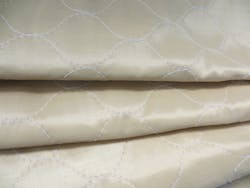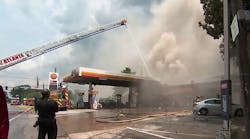In 2012, the DuPont Corp. announced it would cease production of Nomex® filament yarns for the fire service. Nomex filaments have long been favored for use in thermal liner face cloths, where mobility and lubricity are primary concerns for comfort.
As the largest provider of flame-resistant fabric for turnout gear in the world, TenCate used this opportunity to engineer face cloths for thermal liners using Kevlar filament yarns as the replacement for Nomex filament and incorporated specialized fiber blends to improve the performance characteristics of thermal liners in general.
Needs: Thermal liners
Firefighter turnout gear is made of three layers: a tough, tear-resistant outer shell, a moisture barrier and a thermal liner. The thermal liner provides the majority of thermal protection in firefighter turnout gear and impacts total heat loss (THL) or evaporative heat transfer. Firefighters need to consider the “comfort” of the thermal liner since this is the element of the ensemble that is closest to the skin. National Fire Protection Association (NFPA) Standard 1971-compliant thermal liners are generally made of two elements: a thermally insulative batt quilted to a woven face cloth. The batts affect thermal protection and THL. Batts are usually a nonwoven needle-punch or spun-lace, hydro-entangled material.
The face cloth is the fabric that comes into direct contact with the skin. Factors such as feel, smoothness, flexibility, texture and wicking all greatly affect the overall comfort of the thermal liner. Some face cloths are also slick to allow freedom of movement. This is what is called lubricity.
Advantages
The Kevlar filament will provide excellent thermal stability; equal to or better than Nomex. And the tensile strength of Kevlar filament is four times that of Nomex. Kevlar is a great fiber for both strength and fire resistance; unfortunately, it is not for moisture management. Since Nomex filament will no longer be available and only Kevlar filament will be present, more inherently wicking fibers in a variety of blends can be added.
Wicking is an important factor in the thermal liner. The liner must provide protection from heat, but must also allow moisture to evaporate away from the skin. Moisture that is directly adjacent to the skin can become heated in a fire and cause scald burns. With our new designs using Kevlar filament and inherently wicking yarns, wicking performance is greatly enhanced. The net result is that wicking and moisture management are improved making for not only a stronger, more heat- and flame-resistant liner, but a better wicking one as well. These combined factors can only increase the overall performance of the thermal liner and provide better protection for the firefighter who is wearing it.
History
Kevlar is an organic aromatic polyamide, or para-aramid, fiber with high heat and flame resistance that was developed by the chemist and research associate Stephanie Kwolek for DuPont more than 40 years ago. Since thne, Kevlar has been used extensively in protective apparel and anti-ballistic fabrics for firefighters, soldiers and law enforcement officers. It has five times the strength of steel on an equal weight basis. It degrades at above 800 degrees Fahrenheit instead of burning and this was a watershed moment in the production of fabric for firefighter turnout gear.
Kevlar is considered a high-tenacity fiber due to its physical properties. This high strength and a capacity for thermal stability make Kevlar ideal for use in turnout gear and it has become, along with Nomex, a standard, well-known and universally recognized fiber in the industry. It is a very strong, durable fiber, is resistant to chemicals and it has excellent dimensional stability, meaning it retains its shape very well.
All of these factors make Kevlar an excellent candidate for use in outer-shell fabrics for firefighters. It can now also become a primary fiber in the engineering and manufacturing of face cloths for thermal liners. Engineering a blend that contains inherently wicking fibers as well as the Kevlar has been the primary achievement in this process. By increasing the moisture-management performance of the thermal liner, firefighters’ comfort is enhanced, as is their protection.
Application
As mentioned above, the loss of the Nomex filament means that more options for specialized blends can now be realized and used to improve existing face cloths. This also can create new and even more innovative face cloths for the future that will be stronger, more flame resistant and possess better wicking properties. Using inherently wicking fibers means that there need not be any treatment applied to the fabric which will ultimately mean less negative impact on the environment. By combining the increased strength of Kevlar filament with the improved moisture management of inherently wicking yarns in new face cloths, better thermal liners are a certainty for coming developments in the fire service. Firefighters will be able to select from stronger, slicker and better-wicking thermal barriers.
You will be able to recognize Kevlar filament face cloths by their gold color. Dark or bright colors cannot be dyed in Kevlar filament due to the dense molecular structure and heat stability. As has always been the case, firefighters have many options in thermal liners that offer different levels of performance. Do your research and select the thermal liner that best suits your needs.
For more news about technology, visit: http://www.firehouse.com/topics/technology-communications.






